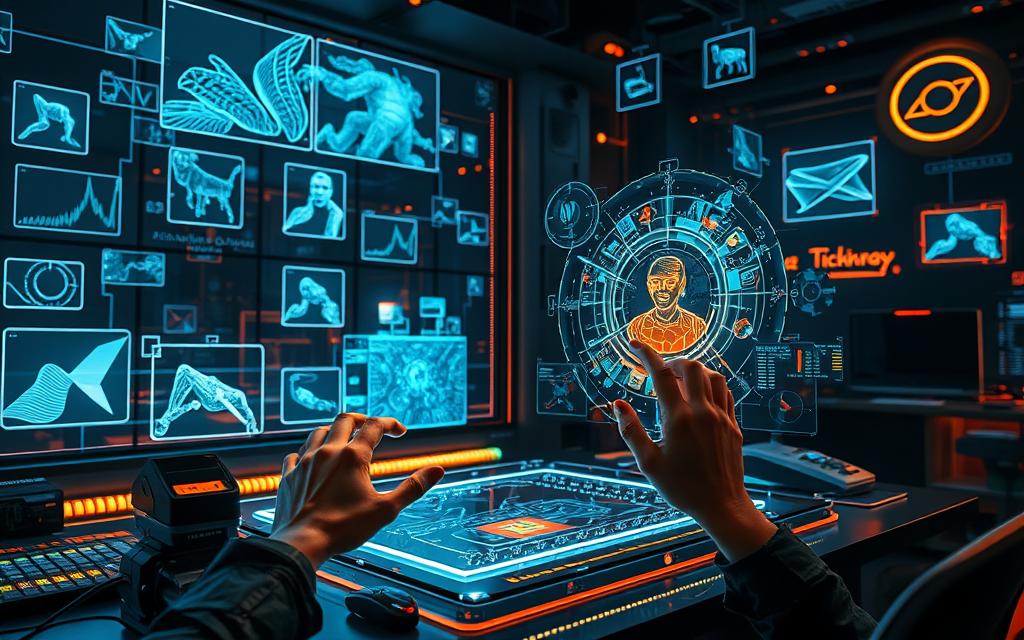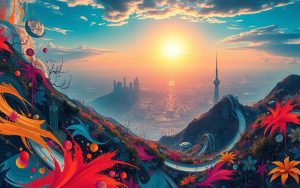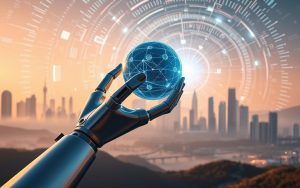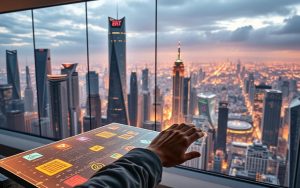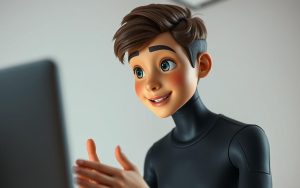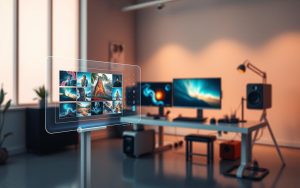Table of Contents
The advent of AI-generated images is revolutionizing the way we create and interact with visual content. With the emergence of AI picture generators, the process of producing high-quality visuals has become more accessible than ever.
This technology is not only transforming the creative industry but also democratizing art creation. Individuals without traditional design skills can now produce professional-quality images with ease. The significance of this shift is profound, impacting various aspects of digital communication and creative workflows.
As we explore the capabilities and applications of AI picture generators, it becomes clear that this technology is set to have a transformative impact on how businesses and individuals create and utilize visual content.
The Revolution of AI-Generated Imagery
AI picture generators are revolutionizing the way we create and interact with visual content. This transformation is rooted in the evolution of AI art, from early experimental systems to today’s sophisticated image generators.
From Pixels to Masterpieces: Understanding AI Art
The journey of AI art has been marked by significant advancements in neural networks and machine learning models. These technologies have enabled the interpretation of text descriptions and their transformation into coherent, detailed visual content.
Why Businesses Are Embracing AI Visuals
Businesses across various industries are incorporating AI visuals into their marketing, product development, and communication strategies. For instance, companies are leveraging AI image generators to enhance their brand presence and customer engagement.
How AI Picture Generators Actually Work
Understanding how AI picture generators work requires a dive into their technological backbone. At their core, these generators rely on complex algorithms and vast datasets to produce images.
The Technology Behind the Magic
The fundamental technologies powering AI picture generators include diffusion models, GANs (Generative Adversarial Networks), and transformer architectures. These AI systems are trained on massive datasets of images and text to learn visual concepts, styles, and relationships.
- Diffusion models progressively refine the image generation process.
- GANs involve a generator and discriminator network that work together to produce realistic images.
- Transformer architectures enable the AI to understand and interpret complex text prompts.
Text-to-Image: Turning Words into Visual Content
The process of generating an image involves analyzing and interpreting text prompts to create corresponding visual elements. When a user enters a text description, the AI progressively builds the requested image through a series of computational steps.
The quality and relevance of the generated image depend on both the sophistication of the AI model and the specificity of the text prompts. Different AI models approach the text-to-image conversion process uniquely, and ongoing training refines their underlying algorithms.
Unleashing Creativity with AI Picture Generators
The emergence of AI image generators has opened new avenues for creative expression. With the ability to generate stunning images instantly, these tools are transforming the way we approach visual content creation.
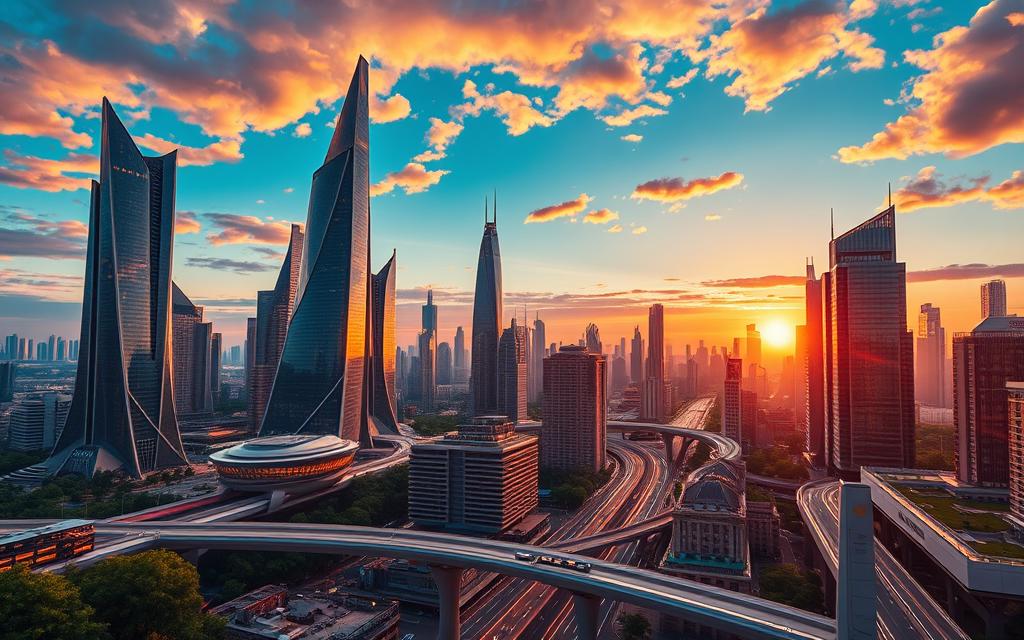
Breaking Creative Barriers
AI picture generators are removing traditional barriers to visual creation, enabling individuals without extensive artistic training to bring their ideas to life. These tools facilitate experimentation by generating multiple variations and alternatives in a fraction of the time it would take using conventional methods.
Democratizing Design for Everyone
By making professional-quality design accessible to small businesses, entrepreneurs, and individuals with limited resources, AI picture generators are changing the landscape of digital communication and marketing. These tools complement human creativity, serving as collaborative partners that expand creative possibilities.
Mastering the Art of AI Prompts
The key to unlocking high-quality AI-generated images lies in mastering the art of prompts. Effective prompts are the bridge between your creative vision and the AI’s ability to bring that vision to life.
Crafting Detailed Descriptions for Better Results
To achieve the best results, it’s crucial to provide detailed descriptions that capture the essence of your vision. This includes specifying the subject matter, style, mood, lighting, composition, and color palette. For instance, instead of using a vague prompt like “a futuristic city,” you could say “a neon-lit, futuristic cityscape at dusk with sleek skyscrapers and a misty atmosphere.” This level of detail helps the AI understand your creative intent and produce images that closely match your expectations.
| Vague Prompt | Detailed Prompt | Resulting Image Quality |
|---|---|---|
| “A futuristic city” | “A neon-lit, futuristic cityscape at dusk with sleek skyscrapers and a misty atmosphere” | Higher quality with detailed prompt |
| “A happy dog” | “A playful golden retriever running on a sunny beach with a ball in its mouth” | Higher quality with detailed prompt |
Refining and Experimenting with Your Vision
Refining your prompts based on initial results is a crucial step in achieving your desired outcome. If the first output isn’t quite what you envisioned, adjust and re-prompt. Experimenting with variations in your description can help refine your image. For example, altering themes, style, or specific elements can significantly impact the final result. This iterative process allows you to fine-tune your prompts and explore different creative possibilities.
By mastering the art of AI prompts, you can unlock a world of creative possibilities and achieve high-quality, AI-generated images that perfectly capture your vision.
Exploring Visual Styles and Customization Options
With AI picture generators, users can explore a multitude of styles, transforming their ideas into captivating visual content. This versatility is a significant advantage, as it allows creators to tailor their images to specific needs and preferences.
From Photorealistic to Artistic Renderings
AI picture generators offer a diverse range of visual styles, from hyperrealistic photography to abstract artistic interpretations. By referencing established art movements or visual media in prompts, users can direct the AI toward specific aesthetic outcomes. For instance, Pixlr’s 16 unique style options enable users to transform their images into captivating works of art, suitable for various moods and themes.
Playing with Colors, Lighting, and Composition
Adjusting style parameters can dramatically change the visual presentation of the same basic concept. Effective control over color schemes, lighting conditions, and compositional elements can be achieved through prompt engineering. By combining different style elements, users can create unique hybrid aesthetics that may not exist in traditional visual categories, thus achieving specific moods and emotional tones.
- Survey the diverse range of visual styles available through AI picture generators.
- Direct the AI toward specific aesthetic outcomes by referencing art movements or artists.
- Control color schemes, lighting, and composition through prompt engineering.
Practical Applications of AI-Generated Images
The practical applications of AI-generated imagery are vast and varied, impacting multiple industries. AI picture generators are being utilized in numerous ways, from creating customized social media content to visualizing product designs.
Marketing and Social Media Content
Marketing teams are leveraging AI-generated images to produce engaging social media content at scale. This approach not only reduces production time and costs but also allows for highly customized visuals that resonate with target audiences. For instance, AI can generate multiple variations of an image to test different marketing campaigns.
Product Visualization and Design Concepts
Product designers are using AI image generation for rapid prototyping and concept visualization. This enables them to explore different design options before committing to physical production. E-commerce businesses are also benefiting from AI-generated product images in various contexts and settings, eliminating the need for expensive photo shoots.
AI-generated imagery is also being used in educational settings to illustrate complex concepts or historical scenarios, making learning more engaging and interactive. The entertainment and publishing industries are exploring AI-generated visuals to enhance their storytelling capabilities.
Enhancing and Editing Your AI Creations
To bring AI-generated images to life, it’s essential to utilize a range of editing techniques and tools. AI-generated images serve as a starting point rather than a finished product, offering vast potential for enhancement and customization.
Post-Generation Tools and Techniques
A variety of editing software and tools can complement AI image generators, from basic adjustments to advanced compositing techniques. For instance, Pixlr Express offers a wide range of advanced AI tools that allow you to perfect every detail of your creations.
Common techniques for enhancing AI-generated images include color correction, sharpening, detail enhancement, and composition refinement. By applying these techniques, you can significantly improve the quality and aesthetic appeal of your AI-generated photo.
Taking Your Images to the Next Level
Combining multiple AI-generated images through layering and masking can create more complex and customized visual outcomes. This process allows for greater creativity and flexibility in achieving your desired visual creation.
To maintain image quality throughout the editing process, especially when preparing images for different publication contexts, it’s crucial to follow best practices and workflow recommendations. This ensures that your final creation is of the highest quality and ready for publication.
By leveraging the strengths of both AI generation and human editing, you can bring your vision to life and achieve professional-grade results. This collaborative process enhances your AI creations, making them more engaging and effective.
Navigating Ethical Considerations and Best Practices
As we harness the power of AI for image generation, it’s essential to consider the ethical implications of this technology. The use of AI generators for creating images and creations raises important questions about copyright, ownership, and responsible use.
Copyright and Ownership of AI-Generated Content
The evolving landscape of copyright and intellectual property as it relates to AI-generated imagery is complex. Currently, different jurisdictions are approaching these questions in various ways, leading to a lack of uniformity in legal perspectives on ownership of AI-created content. For instance, the legalities surrounding AI-generated images are still being debated.
Ensuring Safe and Responsible Use
To ensure safe and responsible use of AI image generators, users must adhere to best practices. This includes avoiding the creation of misleading, harmful, or deceptive visual content. Additionally, disclosure is crucial when using AI-generated images in contexts where authenticity matters. For example, Pixlr’s AI Image Generator allows users to toggle the ‘make private’ button to keep their creations confidential and provides a flag button to report unsuitable images, ensuring a safe environment for all users.
By understanding these ethical considerations and implementing responsible practices, businesses and creators can develop ethical frameworks for their use of AI image generation technology, harnessing its power while minimizing potential risks.
The Future Canvas: Where AI Image Generation Is Headed
The future of AI-generated imagery is rapidly unfolding, with emerging trends and technologies set to revolutionize the field. As computational power and model sophistication increase, AI image generators will become even more powerful tools for creators.
Some key developments to watch include:
- More interactive and collaborative AI image generation tools that function as creative partners.
- Support for animation, video, and interactive media creation.
- Specialized capabilities for different industries and applications.
As AI-generated imagery becomes more prevalent, we can expect both challenges and opportunities to arise. The relationship between human creativity and AI assistance will continue to evolve, with emerging ethical frameworks and potential regulatory approaches shaping the future of AI art and creations.
FAQ
What is the quality of images generated by AI image generation tools?
The quality of images generated by AI image generation tools can be high, depending on the tool and the input provided. Some tools can produce high-resolution images with detailed textures and colors.
Can I customize the style and composition of AI-generated images?
Yes, many AI image generation tools allow you to customize the style, composition, and other aspects of the generated images, such as colors, lighting, and background.
How do I craft effective prompts for AI image generation?
To craft effective prompts, provide detailed descriptions of the desired image, including the subject, style, and any specific elements you want to include. Refining and experimenting with your prompts can also help achieve better results.
Are AI-generated images suitable for commercial use?
Yes, AI-generated images can be used for commercial purposes, such as marketing and social media content, product visualization, and design concepts. However, it’s essential to review the terms of service for the specific tool you’re using to ensure compliance with copyright and ownership guidelines.
Can I edit and enhance AI-generated images?
Yes, you can edit and enhance AI-generated images using post-generation tools and techniques, such as adjusting colors, contrast, and composition. This can help take your images to the next level and achieve the desired look.
How do AI image generation tools handle copyright and ownership?
The copyright and ownership of AI-generated images can be complex and depend on the specific tool and its terms of service. It’s crucial to review the guidelines for the tool you’re using to understand your rights and responsibilities.
Can AI image generation tools be used for artistic purposes?
Yes, AI image generation tools can be used for artistic purposes, allowing artists and designers to explore new ideas and styles. The tools can help break creative barriers and democratize design for everyone.


